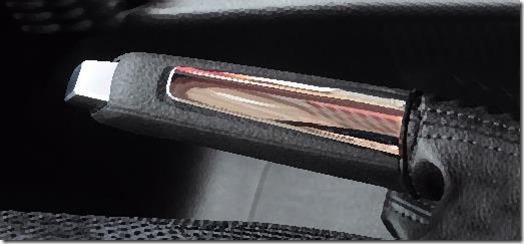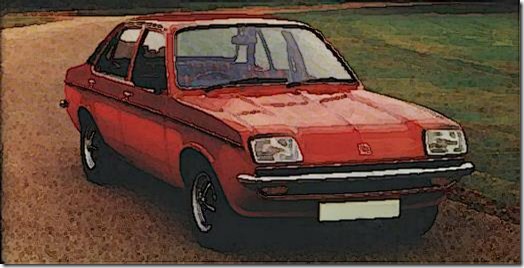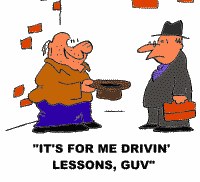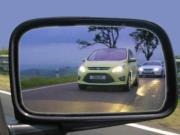I noticed an amusing discussion on a web forum about whether or not to push the button in on the handbrake when applying it. So here are some sensible answers to those questions.
Will I fail my test if I push the button in when I put the handbrake on?
No. The examiner doesn’t mark it.
Will I fail my test if I don’t push the button in when I put the handbrake on?
No. The examiner doesn’t mark it.
What does it mean when someone says to let the handbrake “ratchet”?
It means that you don’t push the button when you pull the lever and allow it to make that familiar clicking sound. 
A ratchet is a mechanical device which only allows movement in one direction. The pawl is the component that holds the ratchet in place. When you push the button in on your handbrake, you lift the pawl so that the ratchet can move freely. A racheting sound is the sound of a ratchet in operation as the pawl moves over each tooth, and it describes that click-click-click you hear. People often refer to this as “letting it ratchet”.
Why was I taught to push the button in when I learnt to drive 30 years ago?
A lot of things change with time. My dad used to fix cars, and I remember once seeing a broken ratchet that had been removed back in the days when you could do that sort of work yourself. It was made out of what looked like die-cast metal and some of the teeth were missing. Therefore, the argument in favour of pushing the button in when applying the handbrake cited wear-and-tear as the reason for not letting it ratchet. Nowadays car parts such as this are built out of hard-wearing synthetic materials and are designed better. Wear-and-tear and poor performance are not really big issues any more.
My car handbook says that I must not push the button in
There have been numerous cases over the years where car handbrakes have spontaneously “released” and let people’s cars roll away out of driveways or down hills. Indeed, my own car will sometimes make a loud “ping” as the brake drops a notch when you let it go. The problem has been so bad in some cases that various makes and models have been subject to recall notices to have new mechanisms fitted. As recently as 2013 Corsa D models were involved in such a recall.
What I believe happens in non-recall cases is that by pushing the button in as you apply the brake, it is possible to let the pawl come to rest ON TOP of a ratchet tooth instead of between two teeth. The increased cable tension (or less stretchy cable) in modern designs allows it to stay there, but as the temperature drops at night the pawl can suddenly pop down on to the next ratchet position. This is why the vehicle handbooks are now worded as they are, and allowing the handbrake to ratchet means that it always settles right between two ratchet teeth.
I was taught in a Vauxhall Chevette, and to push the button in when applying the brake. Old habits die hard, and I still use the button about half of the time. But even pupils who have never been in a car before tend to want to push the button when they apply the handbrake. I make it clear on the first lesson what the manual says and why, and that they should avoid pushing the button.when pulling the lever. However, I also make it clear that pushing the button is not a driving fault. Beyond that, I don’t care how they do it.
Vehicles which have been recalled due to brake problems such as this include various Vauxhalls. I had a Citroen Xantia and it was subject to a recall order to remedy this same kind of fault. However, cars rolling away wasn’t unknown 10, 20 or 30+ years ago. Don’t let people tell you it’s nonsense. It isn’t.
It will wear out if I use the ratchet, won’t it?
Any moving part will suffer wear-and-tear. The handbrake is a safety mechanism, and if any manufacturer started making them out of Play-doh they’d be castrated by the courts in 10 seconds flat. The ratchet is designed to last, not wear out, and if you do get one wearing out in an unusually short period of time it’s probably because it is faulty (as in the case of the Corsa D recall I mentioned above), and not because of how it has been used.
The ratchet won’t wear out abnormally quickly by using it.
So how should I apply it? Button or no button?
It doesn’t really matter. Ideally, do what the manual says. In spite of some of the utter nonsense you hear, it isn’t a conspiracy by manufacturers to make money selling replacement handbrakes. As I said above, the ratchet won’t wear out abnormally quickly if you use it.
If you ever hear a loud noise from the handbrake – like a thump or twang, or anything else that suggests it is dropping down when you let go – consider doing it differently.
I don’t like that rasping noise.
So push the button in, then. But if you’re an instructor who doesn’t like the noise (or who was taught the old way) you really ought to do a reality check before forcing your pupils to do things just to keep you happy. The ratchet is extremely quiet on modern vehicles, so maybe you think you’re hearing more than you actually are, and if your manual says you should allow it to ratchet then you might be passing on potentially dangerous habits.
I hate it when I pick up pupils who have been told to use the handbrake every time they stop.
Well, good for you. However, you need to allow for the fact that most new drivers find it difficult to assess when to do something that should be triggered by judgement or common sense, and often fall into the habit of either always doing it, or always not doing it as a result. They try to pigeon hole everything. So there is a good chance they were not actually told to apply the handbrake “every time”, and have developed that habit themselves as a “just in case” strategy (they do it with signalling to pull over or move off, amongst other things). Mine often try to do it in spite of me never having taught them to.
The Essential Skills (TES) makes it clear that you should use the handbrake where it would help you prevent the car from rolling.
It comes down to two options for many learners. Do they:
- NOT use the handbrake and risk rolling?
- use it EVERY TIME just in case?
The first one carries a significant risk of failing the test and is potentially dangerous. The second is not a fault, nor is it a danger to other road users in itself. The only people who see it as a problem are certain ADIs who seem annoyed by it.
 there is always a risk they’ll disappear completely at some point. Some instructors are so far out of touch with reality that they simply cannot understand how someone without a job and very little money is often going to turn out to be unreliable and highly likely to not be able to afford lessons at all at some stage.
there is always a risk they’ll disappear completely at some point. Some instructors are so far out of touch with reality that they simply cannot understand how someone without a job and very little money is often going to turn out to be unreliable and highly likely to not be able to afford lessons at all at some stage. heir parents (or boyfriends/girlfriends), or think that they’ve just “got to do it” for some reason. The only drawback is that they don’t really want to, and it is therefore easier for them to come up with reasons to skip lessons and eventually just stop altogether.
heir parents (or boyfriends/girlfriends), or think that they’ve just “got to do it” for some reason. The only drawback is that they don’t really want to, and it is therefore easier for them to come up with reasons to skip lessons and eventually just stop altogether. across several lanes because they’re not in the correct one to begin with (and that’s true of many roundabouts).
across several lanes because they’re not in the correct one to begin with (and that’s true of many roundabouts).





 Taking my own pupils as an example, a typical 2 hour lesson can cover anywhere from less than 5 miles to more than 60! It just depends on what you are trying to cover.
Taking my own pupils as an example, a typical 2 hour lesson can cover anywhere from less than 5 miles to more than 60! It just depends on what you are trying to cover. out how much it will cost them to learn to drive, and I make it clear from the outset that if they can get a lot of quality private practice between lessons then they will learn over a shorter time period. I just tell them straight that if they can get insured on mum or dad’s car then that will avoid having to pay me for the road time instead. I also tell them that it is important that mum or dad prevents bad habits forming, so I suggest that they accompany us on a lesson and I show them some things to watch out for.
out how much it will cost them to learn to drive, and I make it clear from the outset that if they can get a lot of quality private practice between lessons then they will learn over a shorter time period. I just tell them straight that if they can get insured on mum or dad’s car then that will avoid having to pay me for the road time instead. I also tell them that it is important that mum or dad prevents bad habits forming, so I suggest that they accompany us on a lesson and I show them some things to watch out for. I noticed recently someone was giving ridiculous advice about stopping in the cyclists’ forward area. Perhaps they should read this and learn.
I noticed recently someone was giving ridiculous advice about stopping in the cyclists’ forward area. Perhaps they should read this and learn.